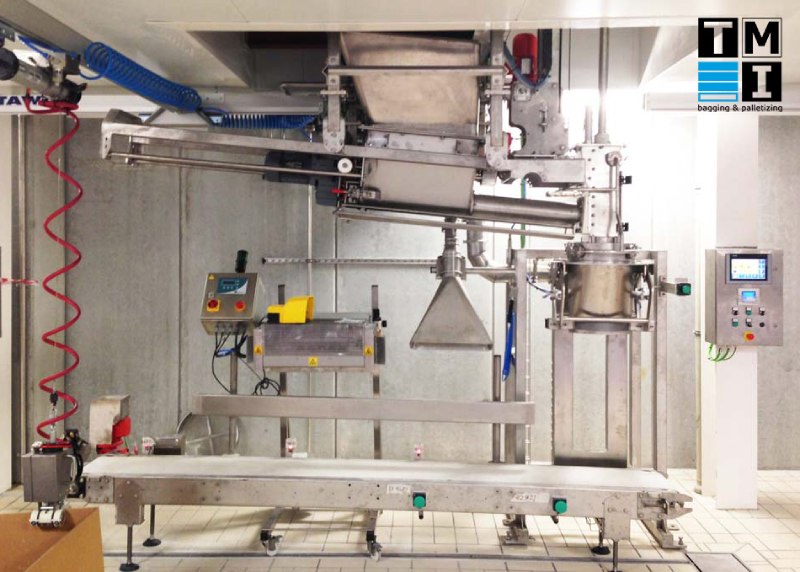Los productores alimentarios tienen una importante e ineludible misión: garantizar la seguridad y la Food producers have an important and unavoidable mission: to guarantee the safety and traceability of their products at all stages of the chain, from the production of each ingredient until the final product is consumed.
To this end, there are various food safety regulations that define, among other things, the requirements to be met by equipment and facilities that may be in contact with foodstuffs. These regulations not only constitute the legal framework that producers must comply with, but also define what is known as hygienic design.
In this article you can find out about the basic principles of hygienic design and its importance in the food industry:
WHAT DOES HYGIENIC DESIGN STAND FOR?
Hygienic design is of major concern in plant and equipment construction, being the systematic focus of the food industry, where ensuring the safety and health of consumers is of paramount importance.
The aim is therefore to eliminate sources of physical, chemical or microbiological contamination of foodstuffs. This is a risk that must be avoided at all costs, and this is achieved by minimising any possible source of contamination, making it visible at all times, and making it easy to clean.
REGULATION OF HYGIENIC DESIGN
In order to ensure the necessary hygienic production conditions, regulations have been established, differing from country to country, which define the criteria to be followed and the measures to be taken in the design of safe equipment and facilities.
In the European Union, the legal framework that defines it is the Machinery Directive 2006/42/EC, together with Regulation (EC)1935/2004 on materials and articles used in contact with foodstuffs, European hygiene legislation and the legislation of the individual member states. In addition, the non-statutory standards ISO 14159 and EN 1672-2 have to be taken into account. These standards define requirements for materials, surfaces, joints, liquid drainage, contamination and cleanability.
Additionally, there is the fundamental role of the EHEDG (European Hygienic Engineering and Design Group), which is the body that assists European legislators, defines and spreads hygienic design standards and provides certification of equipment.
Beyond the EU, there are also other reference regulations: in the USA there are the sanitary standards 3-A, the NSF (National Sanitary Foundation), the FDA (Food & Drug Administration), the GMP (Good Manufacturing Practice) and the HACCP (Hazard Analysis and Critical Control Points); in the UK, there is the BRC (British Retail Consortium).
The norms and guidelines established by all these bodies and systems give rise to what is known as hygienic design, which aims to fulfil the requirements set by them.
Some directives provide for certification of the hygienic design and issuing of certificates if the hygienic design guidelines are met and the prescribed hygiene tests are successfully passed.
BASIC GUIDELINES OF HYGIENIC DESIGN
Basic premises of hygienic design are: to avoid dirt accumulations on all surfaces, making them visible and inspectable, to ensure that cleaning can be carried out easily and to keep the production environment in good condition so as not to constitute a potential contamination source (including the floor of the facility).
Hygienic design concerns the definition of materials, processes, surface treatment, joining techniques and the morphology of the parts themselves in order to ensure the proper construction of the machines to be installed in food production lines and all their components.
Therefore, the following criteria are defined as the basis for hygienic design:
- CLEANING AND SANITIZING: It must be possible to clean the installations, machinery, or surfaces in an adequate manner, eliminating the remains of dirt that can cause the growth of micro-organisms. For this purpose, they must be designed to allow easy cleaning access.
- ACCESSIBILITY: the installation should be easily and tool-free disassembled to ensure access to all areas requiring hygiene, whenever possible and especially when wet cleaning, in which case it should also allow for easy drainage of liquids.
- SURFACES: must be resistant to corrosion generated by the hygiene processes and food itself, while avoiding, as far as possible, the use of surface coatings that could be a source of contamination. They should therefore be smooth, minimising roughness, and dead spots should be avoided. Therefore, they should not contain joints or fissures where leftovers can accumulate, so appropriate welding techniques should be applied for this purpose.
- MATERIALS: The choice of materials is key in the design. Priority is given to materials that are corrosion resistant, non-toxic, easy to clean and prevent the growth of micro-organisms. Stainless steel is generally considered to be the best choice, although corrosion may occur in chemically aggressive environments (e.g. when using cleaning products containing chlorides). For these cases, it is recommended to use FDA and/or 10/2011/EU compliant plastics that are suitable for food contact. The use of metal-detectable plastics is also recommended.
Given all these criteria, it is important to distinguish between surfaces that come into contact with the product and those that do not, for a right assessment on the risk and the hygienic design to adopt in each area.
ADVANTAGES OF HYGIENIC DESIGN
Producers who build their facilities including the hygienic design concept into the plant and into their equipment, achieve:
- FOOD SAFETY: the main purpose is to ensure hygienic production conditions, thus making it easier for food producers to comply with safety regulations and to ensure consumer safety.
- COST REDUCTION: In all production facilities, downtime for cleaning reduces production efficiency and increases costs (labour, energy and quality control). In the case of hygienic design, although it involves a higher investment in the purchase of the equipment, in the long term the TCO (Total Cost of Ownership) is comparatively lower. This is due to reduced cleaning times, energy consumption, personnel costs, together with increased compliance with guidelines and regulations, which results in greater safety for the consumer.
- REDUCED ENVIRONMENTAL IMPACT: The hygienic design, which aims to optimise the sanitising process, allows for a reduction in energy, water and cleaning product consumption.
APPLICATION ON BAGGING LINES
TMI has designed and manufactured many bagging, palletising and stretch wrapping lines for the food industry worldwide, which have included hygienic design in their conception. With the aim of supporting food producers, we have developed solutions that contribute to the following improvements:
EASY CLEANING AND MAINTENANCE
In the bagging process there is one key point where surfaces are of vital importance for food safety: dosing. Here the surfaces are in full contact with the product, and it’s vital that the cleaning can be carried out easily, quickly and thoroughly.
For this purpose, TMI has designed a series of applications that improve maintenance throughout the product dosing units:
-
- Dismountable dosing units: Whether belt or auger dosing units, they can be completely dismantled without the use of tools. This allows operators to carry out a thorough cleaning and inspection quickly and efficiently.
- Automatic water cleaning cycles: Using sprayballs, waterproof connections to water collection systems and air-drying systems, it is possible to initiate automatic water washing cycles from the PLC of the bagging machine itself, optimising cleaning times to the maximum.
- Inclined augers: they allow easy draining of all liquids used in the cleaning cycles.
- No corners: all dosing units are designed to be free of corners where product could accumulate, with open and visible edges, watertight welded joints and no horizontal edges at all.
CLEAN AND SAFE FACILITIES
Beyond dosing, there are many other factors and points in the bagging line where hygienic design is key to ensuring safe food products for consumption:
-
- Materials: TMI can adapt the materials of construction of its bagging machines to the customer’s requirements and washing methodologies. Our bagging machines can be built in stainless steel, partially or completely, and FDA-compliant plastic materials are also used for those elements that for technical reasons cannot be made of steel (e.g. flexible product discharge tubes, telescopic bagging spouts, or mesh conveyor belts).
- Minimising product build-up: flat surfaces are one of the main places where product remains or residual dust accumulate and can become a breeding ground for micro-organisms. To prevent proliferation, TMI applies the EHEDG criteria to hygienic constructions, e.g. with the diamond shape construction, which prevents any build-up due to the edge angles. The contact surfaces between components are also reduced to the essential minimum, including the wiring, which is installed along cable guides for easy access and cleaning without the need for removal, giving priority to a vertical rather than a horizontal position.
- Easy cleaning of the line surroundings: the bagging machines, as well as all bag and pallet conveyors, are fitted with as few floor supports as possible, thus facilitating good hygiene in the immediate area around the bagging line. Moreover, the support legs can be cylindrical and/or made of stainless steel.
- Separate electrical cabinets: placing the electrical cabinet in another room allows water washing cycles to be carried out while preserving the safety of the room where the bagging machine is located. It also enables maximum hygiene to be maintained in cases where the bagging machine is located in a clean room. The cabinets can be equipped with different degrees of IP protection and/or inclination of the upper part of the cabinets, if required by the customer.
TRACEABILITY
Beyond directive definitions and the concept of hygienic design, in many cases it is also considered necessary to integrate metal detection systems along the line, as well as checkweighers, to always ensure the safety of the packaged product. These detection systems can be connected to alarms that instantly notify operators, as well as to data collection systems, so that the manufacturer can have actual data on the conformity of the units produced.
SOME EXAMPLES
Such solutions have been incorporated, among others, in the design of the ILERBAG HC, a tubular FFS bagging machine designed for industries requiring a high level of hygiene; also in the construction of an auger net weight dosing system for glucose for pharmaceutical use; another example is TMI’s latest development: the ILERBAG V for the food industry, a VFFS bagging machine that has been designed based on the requirements of sugar and chocolate producers.
DESIGN THE HYGIENIC END OF LINE YOU NEED
At TMI we are aware that each project has its own specific requirements. Therefore, we assess the hygiene requirements of each individual project and propose solutions that meet them. If you want further information about the solutions that TMI can offer for your project, please contact us by filling in the quotation form: we will help you!


